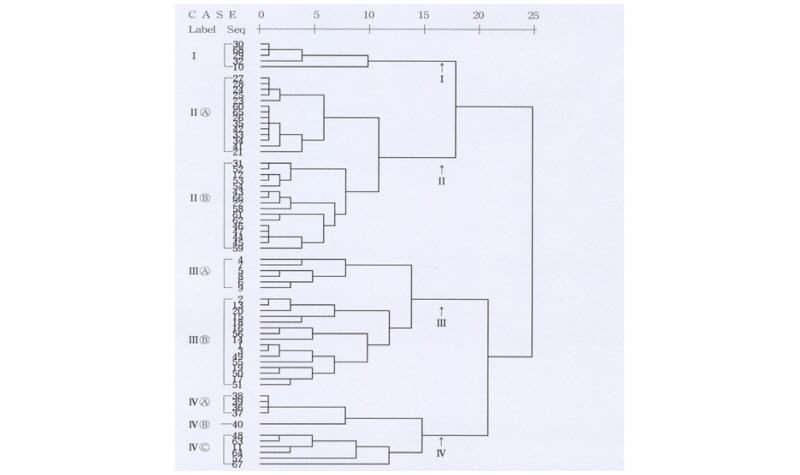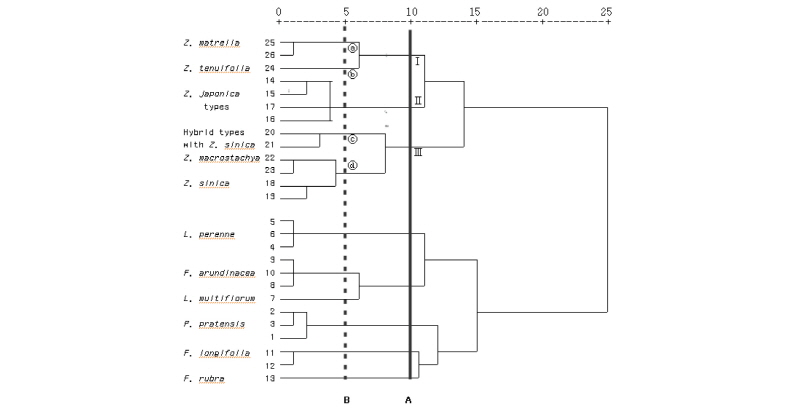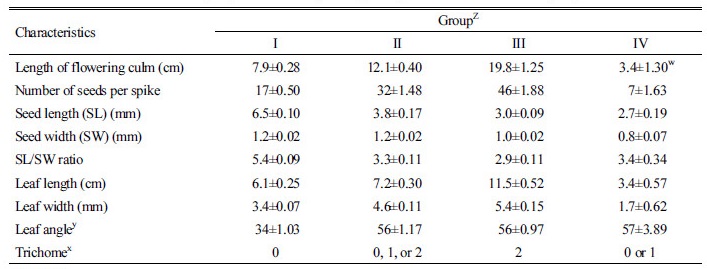서 론
최근까지 한국잔디류는 한국 내에서 사용되는 유일한 잔디의 종이었으며 잔디의 사용과 관련된 학술적 문헌은 매우 제한적이었다. 1950년대 말부터 한국잔디에 대한 학술적 관심이 증가하였다. 초기 연구의 주제는 주로 영양번식의 방법과 종자번식에 관련되었으나 생육 습성과 자연 분포에 대한 보고도 포함되어 있었다(Yu and Yeam, 1968, Yu et al., 1974a). 한국잔디에 관련된 주요 학술 연구는 서울대학교 농과대학의 류와 염 등에 의해 보고 되었으며 미국농무성(USDA)과 서울대학교와의 공동연구를 통해 zoysiagrass의 유전자원이 수집되고 새로운 품종의 육성에 이용되었다(Yeam et al., 1978a, 1978b).
한국 내 잔디와 관련된 산업 규모가 증가하면서 zoysiagrass에 관련된 정보와 소재에 대한 필요가 증가하며 1980년대 후반에서 1990년대 초반 많은 연구가 진행되었다. Zoysiagrass의 사용시 극복되어야 할 가장 큰 문제 중 하나는 라지패치로서 이에 저항성이 높은 신품종 육성과 대처 방법에 대한 관심이 증가하였다. 2002년 한일월드컵의 준비 과정에서 고품질 한지형 잔디의 사용이 증가하였으며 높은 밀도와 세엽 zoysiagrass에 대한 관심도 증가하였다. 2000년도를 전후한 10여년의 기간 동안 400여개가 넘는 골프장이 건설되었으며 다른 복합 스포츠시설과 공원의 녹지 공간에도 잔디가 도입되었다. 그러나 세계 경제 상황의 변화에 따라 저비용 저에너지 소요 잔디와 관리기술에 대한 요구로 인해 고품질 한지형잔디를 대체할 수 있는 zoysiagrass와 기타 내한성이 있는 난지형잔디에 대한 관심이 증가되었다.
본 기고는 한국내에서 zoysiagrass의 분포와 유전적 다양성 및 육종 결과들에 관련된 문헌 자료들이 수집 정리되어 앞으로의 연구에 기여하고자 작성되었다.
Zoysiagrass의 한국 내 분포
자연 상태에서 생육중인 63 zoysiagrass 생태형들이 1965년부터 1971년에 걸쳐 전국에서 수집되어 수원지역의 서울대학교 농과대학 실습농장에 식재된 후 형태적 특성이 조사되었다(Yu et al., 1974a). 수집 장소는 대부분 한반도 도서 지역과 해안지역이 중심이 되었다. 수집된 생태형들은 3개의 Z. tenuifolia 계통, 2개의 Z. sicica 계통, 12개의 Z. matrella 계통과 40개의 Z. japonica 계통들로 구성되었다. 형태적 특성 중 화경의 길이와 초고, 엽폭과 엽초의 길이가 조사되었으며 11개의 군으로 분류될 수 있음이 보고 되었다.
한국 남서해안 지역과 제주도에서 생육 차이를 보이는 93개의 생태형이 1991년부터 1992년에 걸쳐 수집되어 천안에 위치한 단국대학교 연구농장에 식재된 후 특성이 비교되었다(Choi et al., 1997a; Yang et al., 1995). 수집은 종자 특성의 고려를 위해 주로 6월에서 8월 사이에 진행되었다. 수집된 zoysiagrass 들은 종자의 크기, 엽폭, 잎의 각도와 잎털 등의 형태적 특성이 활용되어 4개의 군으로 분류되었다. Table 1에 정리된 바와 같이 Z. japonica (Group III), Z. matrella (Group IV) 는 별도의 군으로 구분되었으며 Z. macrostackya와 Z. sinica (Group I) 는 동일한 군을 형성하였고 한 분류군(Group II)은 Z. japonica와 Z. sinica의 중간 특성을 가진 별도의 군으로 분류되었다. Group III와 Group I의 종자 길이는 각각 2.9 mm와 6.5 mm의 평균을 가진 반면 Group II 는 평균 종자 길이가 4.7 mm로서 중간적 특성을 보였다. 엽폭도 또한 평균 5.1 mm와 3.4 mm가 Group III와 Group I 로부터 측정되었으나 Group II 는 평균 4.1 mm를 보여 중간적 특성을 보였다.
최근 남부산림자원연구소와 단국대학교의 공동 조사가 한반도 전 지역에서 진행되어 159개의 생태형들이 수집되었다(Bae et al., 2010). 연구 결과에 따르면 한반도에는 5개의 군인 Z. japonica, Z. matrella, Z. sinica, Z. macrostackya와 Hybrid zoysiagrass가 서식하고 있는 것으로 보고 되었다. 그러나 Z. sinica와 Z. macrostackya는 형태상 큰 차이를 보이지 않는 것으로 보고되었다.
Zoysiagrass 자연 서식지의 토양 특성이 조사되어 보고되었다(Choi et al., 2012; Lee et al., 2013). 조사지역 중 의 Z. japonica, Z. sinica와 Hybrid zoysiagrass 생태형들의 서식지는 pH 6과 EC 800 µS cm-1 정도를 보였으나 Z. matrella 계통의 서식지는 EC 200 µS cm-1 정도를 보였다.
위의 보고들을 종합 정리하면 Z. japonica는 내륙에서 해안에 걸쳐 두루 분포되어 있고 Z. sinica와 Hybrid zoysiagrass 계통들은 서남해안 근접 지역에 많이 분포하고 있다. Z. matrella는 한반도 남부지방에서 가정 정원, 공원 및 골프장 등에 다양하게 사용되고 있으나 자연 서식지는 많지 않다. 자연적으로 서식하고 있는 Z. macrostackya는 매우 제한적으로 일부 서해 도서지역에서 발견되고 있으며, Z. tenuifolia는 한국에서 자연 서식하는 상태로 발견되지 않고 있다.
한국에서의 zoysiagrass 분류 및 육종 연구
새로운 zoysiagrass 품종의 육성은 몇몇 대학과 국립 및 민간연구소를 통하여 시도되었다. 일부 품종은 상업화 과정 중에 있으나 아직 산업적 이용이 제한적이다. 최근에 등록된 모든 품종들이 영양번식형이며 종자형 품종은 아직 전무하다. 한국의 기후와 사회 여건의 변화에 따라 높은 품질과 라지패치 저항성을 가지고 내건성을 동반하며 녹색 기간이 연장된 새로운 zoysiagrass 품종의 육종에 대한 관심이 증가되고 있다.
Zoysiagrass는 자연 방임 상태에서 교차수분될 확률이 상당히 있기 때문에 종이 혼합된 자연 서식지에서 많은 유전적 다양성을 보이고 있다. Zoysiagrass의 분류는 연구자들의 기준과 대상 소재의 구성에 따라 차이를 보여 혼동의 여지가 있다. Yeam et al. (1978a, 1978b)은 형태적 특성들과 동위효소를 이용한 분류에서 zoysiagrass를 6개의 군으로 나누었으며 Z. japonica, Z. koreana, Z. matrella, Z. sinica, Z. macrostackya, Z. teuifolia와 한 계통의 세엽 Z. japonica, 그리고 별도로 Philippine 과 Taiwan 지역으로부터 수집한 2군의 존재를 보고하였다.
한국 남서해안 지역에서 자생하고 있는 zoysiagrass 생태형들과 미국에서 실험용으로 도입된 Z. tenuifolia를 포함한 소재들을 대상으로 zoysiaggrass를 재 분류한 연구에서 분류의 기준에 잎과 종자의 형태적 특성 및 화경의 길이가 포함되었다(Choi et al., 1997a). 결과는 Table 1에 정리된 바와 같이 4개의 군으로 대별하였으나 기준에 17 RAPDs 마커가 포함되어 분류한 연구 결과 4개의 군이 추가로 구분되어 8개의 군이 보고 되었다(Choi et al., 1997b). Fig. 1에 정리된 8개의 군은 구분된 Z. sinica, Z. macrostackya와 각각 Z. sinica와 Z. japonica의 특성을 더 많이 가진 2개의 중간적 Hybrid 군들, Z. matrella와 다소 차이를 보이는 변종 군과, Z. japonica, Z. matrella와 Z. tenuifolia로 구성되었다. 한국에서 많이 사용되어 온 중지류인 안양중지, 삼덕중지와 Yeam et al. (1987a, 1987b)에 의해 보고된 Z. koreana는 중간적 hybrid 군에 속하였다. Table 2에 정리된 바와 같이 8개의 군별 종자의 특성들은 상당한 차이를 보였고 종자의 길이와 종자의 폭 대비 길이의 비율은 8개의 군을 구분함에 유용하게 사용될 수 있다.

Fig. 1.
Dendrogram of 68 zoysiagrasses based on squared Euclidean distance from 17 RAPD markers. I= Z macrostachya types, IIⒶ= Z. sinica types, IIⒷ= NHSJ (natural hybrid types between Z. sinica and Z. japonica), IIIⒶ= Z. japonica types, IIIⒷ= NHJS (natural hybrid types between Z. japonica and Z. sinica), IVⒶ=Z. matrella types, IVⒷ= Z. tenuifolia types, IVⒸ= NVM (natural variant of Z. matrella) (Choi et al., 1997b).
RAPDs를 이용한 유전적 유사도 추정을 통해 zoysiagrass 종들과 생태형들은 대표적인 한지형잔디들과 동시에 비교 되었다(Choi, 1997; You and Choi, 1998). Fig. 2에 정리된 바와 같이 Poa pratensis, Lolium perenne, Lolium multiflorum, Festuca arundinacea, Festuca longifolia와 Festuca rubra가 다른 종으로 구분되는 유전적 유사도 수준을 zoysiagrass의 종간 비교에 적용하면 1) Z. matrella, 2) Z. tenuifolia, 3) Z. japonica, 4) Z. macrostachya and Z. sinica, 5) Hybrid zoysiagrass의 5개 군으로 분류될 수 있다.

Fig. 2.
Dendrogram of cool-season turfgrasses and zoysiagrass based on squared euclidean dissimilarity distance from 51 RAPD markers. A: Classified at squared euclidean distance 10 level; B: Classified at squared euclidean distance 5 level. Iⓐ: Z. matrella; Iⓑ: Z. tenuifolia; II: Z. japonica and hybrid types with Z. japonica characteristics; IIIⓒ: Hybrid types with Z. sinica characteristics; IIIⓓ: Z. sinica and Z. macrostachya type (You and Choi., 1998).
초기의 생태형 수집을 통해 육성되어 보고된 품종들인 ‘Green Paradise’, ‘New World’와 ‘Happy Home’ 등은 세엽을 가진 것으로 보고되었으나 산업적 이용과 품종화가 계속적으로 진행되지 못하였다(Yu et al., 1974a). Hong and Yeam (1985)과 Kim et al. (1996)은 zoysiagrass의 종간 교잡 결과를 보고하였다. 교잡종들은 형태적으로 양친의 중간적 형질을 보였으며 생육면에서 잡종강세를 보였다. Colchicine 처리에 의한 배수성 zoysiagrass가 유도되었으나 추가의 연구를 통한 육종에의 적용은 보고되지 않았다(Lim et al., 1990). Gamma-ray가 조사되어 돌연변이가 유도되고 변형된 zoysiagrass의 육종연구가 충남대학교와 제주대학교에서 진행되고 있다(Lee et al., 2014).
분자생물학적 접근을 통한 육종 결과를 보면, 제초제 저항성 유전자가 electroporation, particle bombardment와 agrobacterium inoculation등의 방법을 사용하여 Z. japonica의 배발생 세포들로 도입되었음이 보고되었다(Park et al., 1994; Lim et al., 2004; Sun et al., 2010). 그러나 GMO 관련의 법적 절차가 완료되지 않아서 산업적으로 이용되고 있지는 않다(Lee et al., 2014).
생태형들의 수집을 통한 전통적 선발 육종방법을 이용하여 영양계 품종들이 육성되어 특허와 품종보호를 통해 등록되고 있다. Table 3에 정리된 품종들 중 ‘Anyang’과 ‘Jangsung Satbyol’은 Hybrid type이고, ‘Jangsung Chorok’은 Z. japonica type이며 Z. matrella type으로 ‘Kunhee’와 ‘Green-Ever’가 등록되었다(Kim et al., 2000; Tae et al., 2014). 수집종들의 교배를 통해 ‘Senock’ 과 ‘Semil’ 이 육성되었으며(Choi and Yang 2004), ‘Millock’은 유전적으로 고정되지 않은 영양계 zoysiagrass를 자가수분한 후대에서 선발되었다(Choi and Yang, 2006b).
한국에서 사용되고 있는 종자형 품종들은 대부분 Z. japonica ‘common’ type 이며 중국으로부터 수입되어 사용되고 있다. 미국에서 육성된 종자형 품종인 ‘Zenith’가 수입되어 사용되기도 하였다.
Zoysiagrass 자생종들이 소수의 대학과 국립 및 민간 연구소들에 의해 수집되어 형질이 평가되고 유전자원으로 보존 관리되고 있으며, 생육 잠재력과 내환경성들이 평가되어 보고되었다(Kim et al., 1996; Choi and Yang, 2005, 2011; Choi et al., 2012). 높은 내한성이 Z. japonica 계통들로부터 보고되었고, 비교적 세엽의 zoysiagrass 로부터는 내염성 형질들이 발견된다고 보고되었다(Choi et al., 2008).
일부 zoysiagrass 종들의 암술 및 수술 전개 시기를 포함한 개화 시기가 조사되어 보고되었다(Choi et al., 2008). 다른 종들을 혼합하여 식재한 실험구에서 자연적으로 방임수분 된 종자들의 후대 확인을 통해 자연적인 종간 교잡종의 생성 가능성을 보고 하였으며, 근거리에 분포하여 생육 중인 zoysiagrass의 종간 교잡 확률이 11.3-48.9% 정도가 될 것으로 보고되었다.
이상의 분류와 육종 관련 보고들을 간단히 종합하면, 대부분의 육성된 한국 내 zoysiagrass 종 및 품종의 분류와 육종은 자생자원을 다양한 지역에서 수집함으로부터 시작되었다고 할 수 있다. 종의 분류 기준이 정확하게 확립되지는 않았으나 내륙 지역과 해안지역에는 모두 엽폭이 넓은 Z. japonica가 많이 분포하고 있으며, 서남해안지역과 도서지역을 중심으로는 중엽형 종간 교잡종이 상당수 자생하고 있는 것으로 추정된다. 상업적으로 ‘중지’로 유통 이용되고 있는 잔디 품종들은 이 생태형으로부터 선발된 잔디 품종으로 생각되며, Z. japonica와 Z. sinica 혹은 Z. macrostachya 간에 자연 교잡을 통해 자연 육성된 Hybrid zoysiagrass 인 것으로 추정된다. 최근에는 Z. japonica, Z. sinica와 Z. matrella 간의 인공 수분을 통해 밀도가 높고 세엽인 잔디 품종들이 육성되고 있다.
Zoysiagrass의 생산과 이용
한국 내 초창기 잔디관련 연구 중 많은 비중을 가진 주제는 잔디의 번식방법과 종자휴면 타파방법에 관한 내용이었다(Yu et al., 1974b, 1975). 종피처리를 위해 KOH 처리(20%, 30분)가 이용되었으며 광처리가 발아력을 향상시킴이 보고되었다. 1990년대 중반까지, zoysiagrass는 평떼 및 줄떼 식재와 함께 종자 파종과 줄기 식재가 골프장 및 도로변 잔디조성에 많이 사용되었으나, 가장 큰 면적은 묘지 조성용 소형 평떼가 중심이 되었다.
한국내 잔디의 총 생산면적은 2,947 ha로 추산되며, 전남 장성과 광주 지역이 한국내 잔디 떼 생산의 약 48%를 차지하고 있다고 보고되었다(Choi and Yang 2006b). 생산되는 잔디 중 중지(중엽형, Hybrid type)가 55.5% 이며 Zoysia japonica가 37.4%, Zoysia matrella가 1.1%, 그리고 0.1%가 zoysiagrass 신품종이며, 3.8%가 kentucky bluegrass, 0.6%가 creeping bentgrass이고 1.9%가 기타 잔디 초종으로 보고되었다. 잔디떼의 생산규격은 18×18cm (43.5%), 20×20cm (14.5%), 30×60cm (2.9%)와 기타 규격(5.8%)이며 33.3%는 주문자의 요청 규격을 따른다고 보고되었다.
한국 내 생산되는 잔디떼의 품질에 주로 라지패치 병과 잡초의 문제가 동반되어 왔다. 그러나 최근 종과 품종의 혼합으로 인해 균일도가 떨어지는 문제가 보고되었으며, 구 품종으로부터 신품종으로의 전환 시 철저한 품질의 관리가 필요한 것으로 생각된다(Choi et al., 2012).





